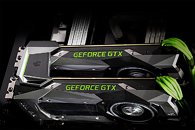Thursday, May 12th 2016

NVIDIA to Focus on 2-way SLI with GeForce "Pascal"
At its GeForce GTX 1080 launch event, NVIDIA is said to have told the press that with its GeForce "Pascal" series, the company will focus on 2-way SLI "for maximum performance," implying an uncertain future for 3-way and 4-way SLI. The company's new SLI HB bridge introduced with the GTX 1080, enables higher bandwidth between two graphics cards in SLI, letting them more reliably render games at high resolutions. On the downside, this new bridge occupies both SLI contact points on each card, in 2-way SLI.
It might still be possible to do 3-way and 4-way SLI using a classic 3-way or 4-way bridge included with your motherboard. You'd be at the mercy of applications somehow being able to take advantage of 3-4 GPUs, NVIDIA on its part, will likely only optimize its drivers for 2-way SLI. The knight in shining armour here is DirectX 12 native multi-GPU, which doesn't care how many GPUs you're using, or if they're even the same kind (as long as the GPUs and the app support Direct3D 12).
Source:
TechofTomorrow (YouTube)
It might still be possible to do 3-way and 4-way SLI using a classic 3-way or 4-way bridge included with your motherboard. You'd be at the mercy of applications somehow being able to take advantage of 3-4 GPUs, NVIDIA on its part, will likely only optimize its drivers for 2-way SLI. The knight in shining armour here is DirectX 12 native multi-GPU, which doesn't care how many GPUs you're using, or if they're even the same kind (as long as the GPUs and the app support Direct3D 12).

63 Comments on NVIDIA to Focus on 2-way SLI with GeForce "Pascal"
Even with Nvlink, the GPUs will still have to work on independent work or be continously synchronized, which will kill performance. This is why multi-GPU works so well for compute and so badly for gaming.
When rendering a frame the allocated GPU memory is typically divided into three categories; output framebuffer, temporary buffers and (static) "resources"(meshes, textures, displacement maps, etc.). The "resources" is the largest part, and have to be duplicated to every GPU in a multi-GPU configuration. Even if we attempted to do SFR again, it would still have to be duplicated. Only if someone creates multiple GPUs on a interposer with an extremely wide link can we avoid this duplication.Nope, that's a misconseption. See above.For AFR mode, the count of GPUs doesn't really matter. In theory you could use 16 GPUs if the hardware allowed it.
SLI and Crossfire's days are numbered because in DX12 and Vulkan, the power is in the developers' hands to do whatever they want with the GPU cores. It'll largely be up to the game engine to load balance.
Go hug your wife.
On a serious note, it is disappointing Nv didnt do away with the bridge. Is the tech AMD use patented? Or is it to keep another Nv peripheral item for absolute financial gain?
Either way, 3 way sli was always massively niche and a diminishing return. Even triple crossfire was not as good a step as going from 1 to 2.
But I don't care much about both techniques, DX12 multi adapter is the way to go.
PhsyX is dead; NVIDIA killed it.